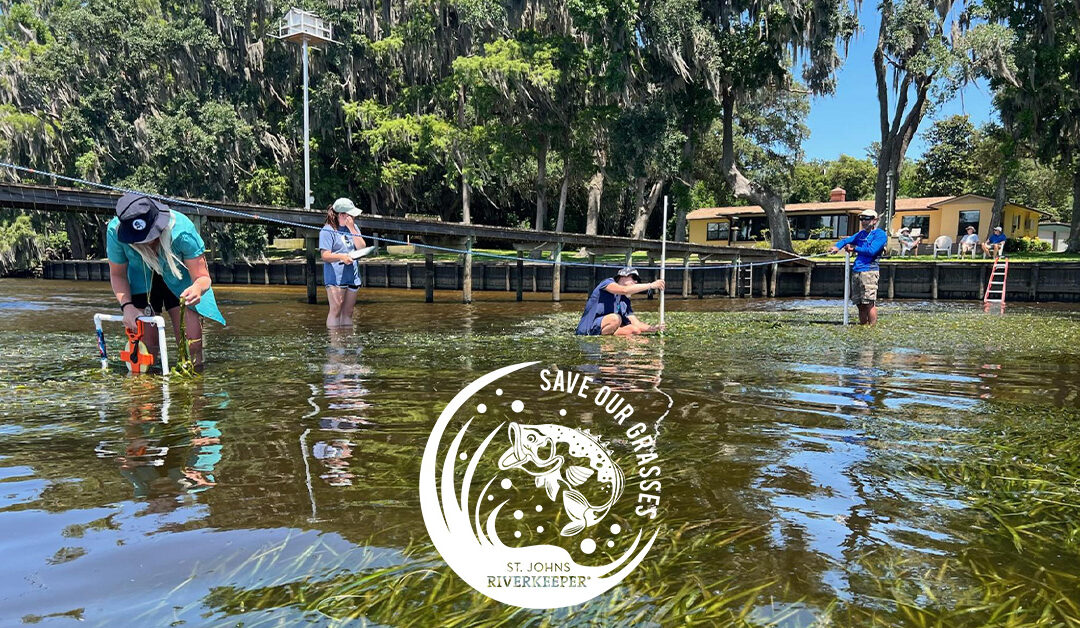In August, St. Johns RIVERKEEPER (SJRK) returned to the river for its second field visit of the 2024 SAVe Our River’s Grasses Expedition seeking answers and solutions to help the struggling SAV of the St. Johns.
Submerged aquatic vegetation (SAV) is the foundation of our river’s health – providing biofiltration, fish habitat, nourishment for aquatic species and more. Sadly, the St. Johns River is suffering mounting threats resulting in severe stress on our river’s SAV.
Over four days, SJRK surveyed an 80-mile stretch of the river between Doctors Lake and Lake George searching for remaining grass beds, taking measurements, conducting water quality testing, and seeking solutions to restore this vital habitat. SJRK’s August 2024 Expedition yielded mixed results, presenting both encouraging and discouraging findings.
- Canopy heights have improved at two sites since May of this year and at three sites since last August.
- At Dancy Point, SAV density has improved both inside and outside the protective enclosure since May, while canopy heights inside the enclosure have seen a remarkable increase compared to last August. The average height now measures 50 cm, a significant rise from last year’s average of just 6.3 cm. Some blades of SAV grew to nearly a meter in length.
- Water temperatures were noticeably warmer, with elevated readings at seven sites compared to August 2023. Eelgrass does not tolerate excessively high temperatures well. The upper limit is between 95-105℉ (35-40℃). Exceeding this range can damage the foliage and flowers, leading to wilting, drooping, and even leaf sunburn, from which eelgrass may struggle to recover. Studies have shown that eelgrass thrives best in temperatures around 82°F. Four sites read in the mid-80s (84-85°F), while 10 sites ranged from the high 80s to low 90s (86-93.5°F).
- Chlorophyll-a indicates the concentration of algae in a waterbody. Eleven out of the 14 sites exceeded the healthy parameter for Chlorophyll-a, which should be less than or equal to 5.4 micrograms per liter (µg/L).
- Similar to August 2023, seven of our 14 SAV sites had potentially toxic cyanobacteria present and prevented our team from entering the water following safety protocols. Cyanobacteria, a/k/a harmful algal blooms (HAB), can be highly toxic and dangerous to human health. Lab results revealed the presence of at least three types of potentially toxic cyanobacteria in the samples analyzed. Toxicity results are pending.
- SAV was found at all the surveyed sites that were accessible.
- Grazing pressure from aquatic species continues to be a major stressor affecting the recovery of SAV, as evidenced by the sparse and heavily cropped grasses that were observed compared to that of the SAV within the protective enclosures.
Implementing Solutions Now
Permitting is underway for the installation of smaller protective enclosures along the 80-mile SAV expedition route in partnership with riverfront homeowners. This initiative supports the Florida Fish and Wildlife (FWC) project, which has been evidenced to play a crucial role in efforts to restore this essential habitat. We are excited to announce our budding partnership with Mighty River Recovery to install 10 enclosures by the end of the year.
The next 2024 SAVe our River’s Grasses Expedition field visit will be in October. We will collect more data to better understand our river and its significance to our communities, our economy and our lives.
SJRK wants to express our gratitude to our partners and friends, including riverfront residents and their neighbors, advising scientists, community leaders, anglers, and river enthusiasts that have been instrumental in this effort and for our ongoing partnership to SAVe our River’s Grasses.
Learn more about the SAVe Our River’s Grasses Expedition.
You Can Help Us Save Our River’s Grasses
St. Johns RIVERKEEPER is conducting three 80-mile research trips this year as part of our five-year expedition to SAVe Our River’s Grasses. Each multi-day trip costs up to $15,000 for staffing, water quality testing, lodging, fuel, equipment, and supplies. Please consider a gift to support our efforts to protect and restore these vital grasses.
